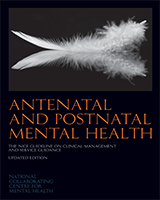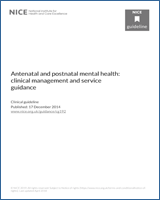NCBI Bookshelf. A service of the National Library of Medicine, National Institutes of Health.
National Collaborating Centre for Mental Health (UK). Antenatal and Postnatal Mental Health: Clinical Management and Service Guidance: Updated edition. Leicester (UK): British Psychological Society; 2014 Dec. (NICE Clinical Guidelines, No. 192.)
April 2018: Footnotes and cautions have been added and amended by NICE to link to the MHRA's latest advice and resources on sodium valproate. Sodium valproate must not be used in pregnancy, and only used in girls and women when there is no alternative and a pregnancy prevention plan is in place. This is because of the risk of malformations and developmental abnormalities in the baby.

Antenatal and Postnatal Mental Health: Clinical Management and Service Guidance: Updated edition.
Show detailsBOATH2003
Boath E, Major K, Cox J. When the cradle falls II: the cost-effectiveness of treating postnatal depression in a psychiatric day hospital compared with routine primary care. Journal of Affective Disorders. 2003;74:159–166. [PubMed: 12706517]
| Study, year and country | Intervention details | Study population Study design – data source | Study type | Costs: description and values Outcomes: description and values | Results: cost effectiveness | Comments Internal validity (Yes/No/NA) Industry support |
|---|---|---|---|---|---|---|
| Boath et al, 2003 UK | Intervention: Specialised psychiatric parent and baby day hospital unit (PBDU) Comparator: Routine primary care (RPC) provided by GPs and health visitors with occasional referrals into secondary care | Women with a baby aged between 6 weeks and 1 year, EPDS score ≥ 12 anda diagnosis of major or minor depressive disorder according to RDC; exclusion criteria: puerperal psychosis, schizophrenia, history of drug or alcohol abuse, women not speaking English Data source for effect-size measures and resource use: prospective cohort study N = 30 in each arm | Cost-effectiveness analysis | Costs: Healthcare costs: Staff: GPs, health visitors, CPNs, mental health resource centre, PBDU Inpatient and day care Capital costs and equipment of PBDU Antidepressant medication Patient costs: transport, childcare Patient time losses: employment, housework, leisure Total costs (referring to 30 women per arm): PBDU group: £46,211 RPC group: £18,973 ΔC: £27,238, p < 0.001 Primary outcome: Number of women successfully treated; recovery defined as no longer fulfilling RDC for major or minor depressive disorder PBDU group: 21 women successfully treated RPC group: 7 women successfully treated ΔE = 14, p < 0.001 | ICER of PBDU versus RPC: £1,945 per successfully treated woman Cost-effectiveness ratio of RPC: £2,710 per successfully treated woman. Authors' conclusion: PBDU more cost effective than RPC Results sensitive to exclusion of costs associated with non-significantly different resource use, that is, medication and GP/health visitor costs |
|
- 2007 HEALTH ECONOMICS EVIDENCE ON MOTHER AND BABY UNITS - Antenatal and Postnata...2007 HEALTH ECONOMICS EVIDENCE ON MOTHER AND BABY UNITS - Antenatal and Postnatal Mental Health
- METHODOLOGY CHECKLIST FOR CLINICAL STUDIES AND REVIEWS - Antenatal and Postnatal...METHODOLOGY CHECKLIST FOR CLINICAL STUDIES AND REVIEWS - Antenatal and Postnatal Mental Health
- ring finger protein 213, partial [Sebastapistes tinkhami]ring finger protein 213, partial [Sebastapistes tinkhami]gi|469609698|gb|AGH61926.1|Protein
- Shigella flexneri 2002017, complete genomeShigella flexneri 2002017, complete genomegi|281599365|gb|CP001383.1|Nucleotide
Your browsing activity is empty.
Activity recording is turned off.
See more...
